The 2019 Honda Passport and Chevrolet Blazer vs. the Ford Edge, Nissan Murano, and Hyundai Santa Fe

Just when you thought there was no room left on the crossover carving station, here come two new two-row SUVs looking for space alongside our three assembled slabs of prime beef. We chose just three established middle grounders as foils for the the Chevy Blazer and the the Honda Passport because, come on-where do you stop? If we'd gathered the whole class, we'd need an extra magazine's worth of pages to cover them all. Then we'd have to rename ourselves Tranquilizer and Apnea.
So each vehicle here is either all new-though, yes, both the Blazer and the Passport share their platforms with existing models-or recently updated. Despite subtle feints toward luxury in one particular crossover's interior, these are normal SUVs for normal people, the kind that line your block. All are all-wheel drive, and their prices range from about $40,000 to $51,000. Certainly there were others considered: Dodge's Journey and Toyota's 4Runner are the right size, but the former is old enough to make a CD changer look new and the latter prefers rock crawling to mall hauling. And Kia's Sorento is exclusively a three-row ute this year, much like the Toyota Highlander, which gave up its five-seat configuration back when crossovers began crossing over.
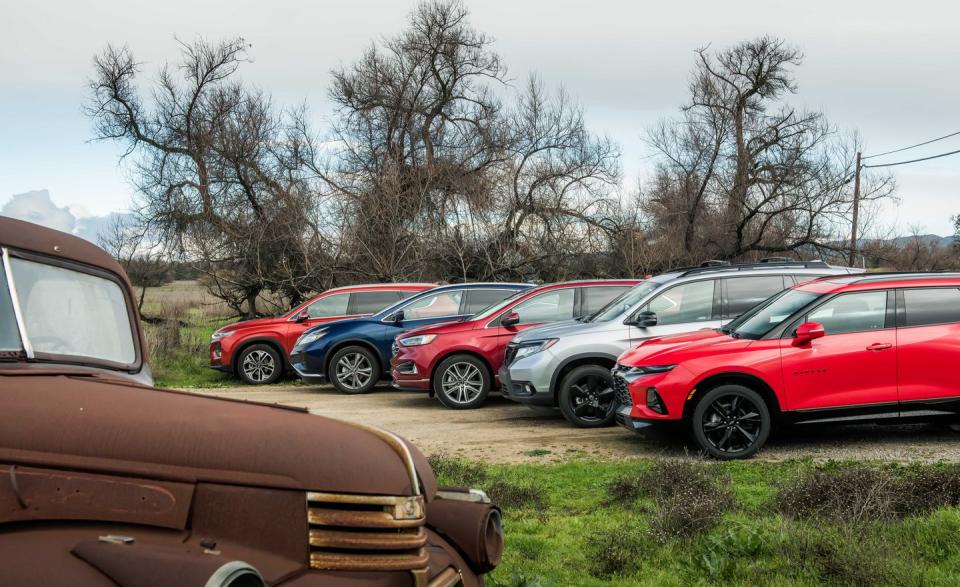
Chevy is slipping the newly reimagined Blazer between its existing utes, the Equinox and Traverse, because, as deputy editor Daniel Pund puts it, "You can't have too many of these things." Built on the same platform as the Cadillac XT5 and GMC Acadia, it starts just under $30,000. But with a 308-hp 3.6-liter V-6, a torque-biasing rear differential, and almost every luxury and tech option available, our RS-trim example came in at $50,765.
Ford's Edge was the subject of a recent mid-cycle refresh, which updated its styling, gave every trim a new eight-speed transmission, and added a handful of driver-assist features. The new Edge ST, with its twin-turbo V-6 and its $43,450 starting price, just didn't fit our pragmatic-family-mover mold quite as well as the turbocharged 2.0-liter version. Starting at $41,850, our option-laden Titanium trim totaled $48,085.
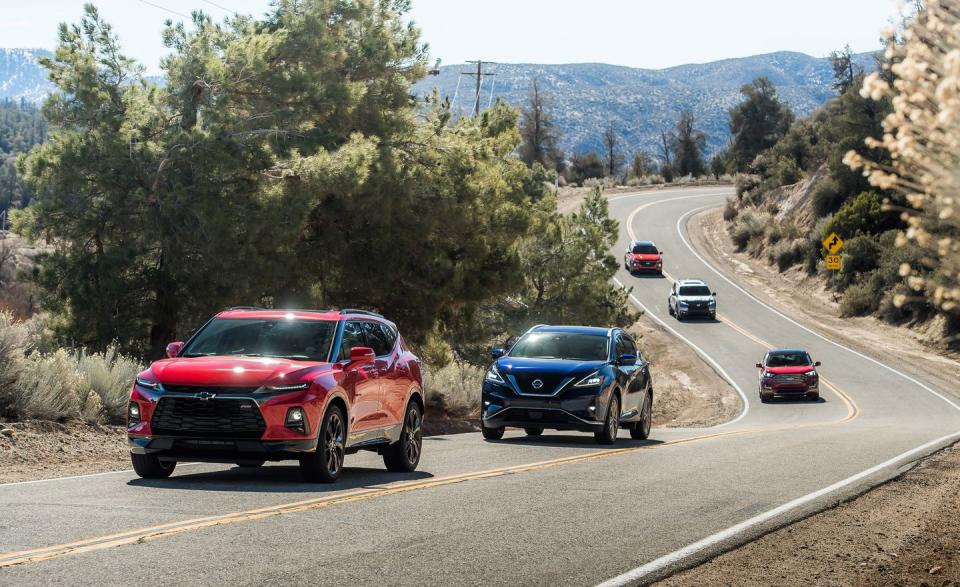
After a long hiatus and a segment change, the Honda Passport is back. It looks like a downsized Pilot because that's essentially what it is, sharing the larger vehicle's 3.5-liter V-6, its torque-biasing rear differential, and most of its platform. Even the price tag recalls a slightly smaller Pilot's. Our top-of-the-line Elite trim is a $45,695 proposition.
Hyundai's all-new Santa Fe joins this buffet after adding 2.6 inches to its wheelbase for 2019. Don't confuse it with the longer, three-row Santa Fe XL or the older Santa Fe Sport from which it evolved. Instead, relish the Ultimate trim's long list of features and modest $39,980 as-tested price. Under its hood resides the test's second turbocharged 2.0-liter inline-four paired with an eight-speed automatic transmission.

Nissan's Murano gets a facelift for 2019 with a new grille and bumper. Top-trim models, like our $46,420 Platinum, get semi-aniline-leather seats with diamond-quilted inserts plus a slew of active-safety features, such as standard automated emergency braking with pedestrian detection, blind-spot monitoring, rear-cross-traffic alert, lane-departure warning, and more. Nissan's 3.5-liter V-6 and continuously variable transmission carry over unchanged from last year.
We took these SUVs to California's southern and central valleys, driving faster than necessary and mulling over their strengths, weaknesses, and agonizing sameness. But in time, their differences emerged, congealed, and became impressions strong enough to argue about. And after three days and 550 miles, we made the hard choices. Here they are:
5th Place:
Nissan Murano

Highs: Cushy front seats, best ride in the group.
Lows: Raucous engine, F-body space efficiency, CVT.
Verdict: Perfect if all you ever do is coast short distances downhill with a single passenger.
Truth is, depending on your priorities, you could buy any of these elevated wagons and probably be happy. None are stinkers. None are single-task specialists. And none are going to break any back-road records, especially the third-generation Murano. It is a curious thing that marches to the beat of its own Franco-Japanese drummer, prioritizing amenity over pace and space. Its ride was by far the most compliant and relaxed in this fivesome. Like many Nissans, the Murano features soft seats that will cradle your backside comfortably for days on end, and it pillows over expansion joints more gracefully than anything else here. Should you want those things, it's an easy choice.
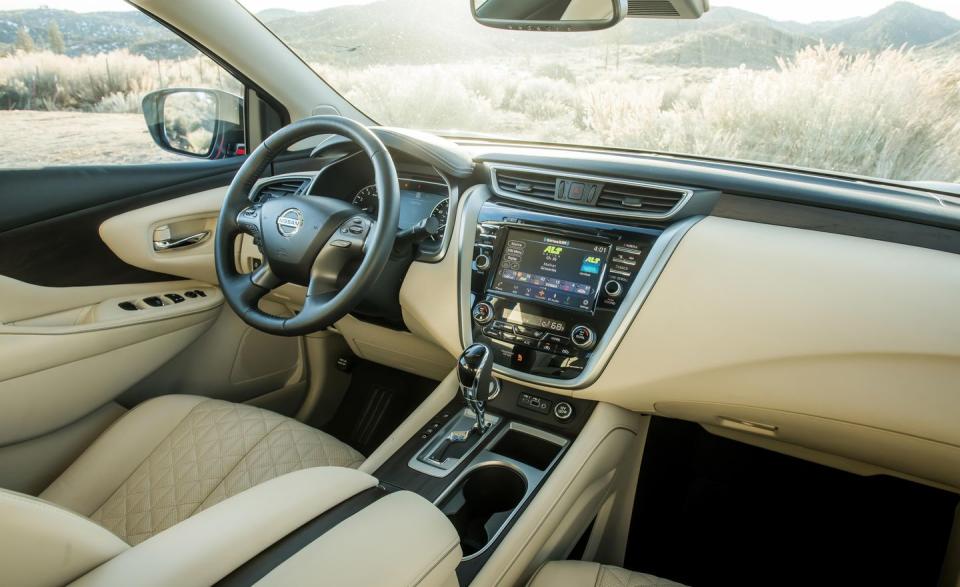
But know that this ease is packaged with the space efficiency of a 1985 IROC-Z. Despite being the longest vehicle in this test, the Murano ties the Blazer for the least cargo space behind its second row and claims just a single cubic-foot advantage in passenger space over the tightest-in-test Chevy. Visibility isn't great, either. "The White House has thinner pillars," read the logbook. But that's hardly all.
A CVT is never a good way to start a relationship with C/D editors, but the Murano's is particularly troublesome since it's paired with a not particularly smooth V-6 that reaches 4400 rpm before achieving peak torque, an experience that rapidly torpedoed any charitable thoughts we had about the Nissan's luxury pretensions. The Murano finds itself, quilted seats and all, in fifth place by virtue of its last-place finishes in the transmission and the fun-to-drive scoring. Tying the Santa Fe for the laziest zero-to-60 time (7.5 seconds) and turning the slowest quarter-mile were just garnish on the gristle.
4th Place:
Ford Edge
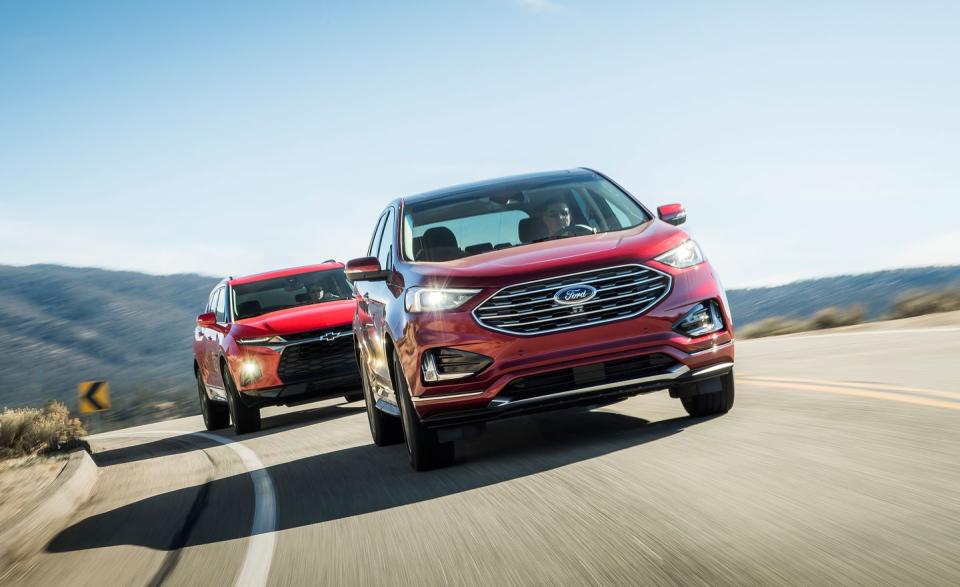
Highs: Seriously silent, low-stress engine, good grip.
Lows: Tall hoodline, bizarre control relationships, overweight, underdamped.
Verdict: It's as awkward in daily use as it is on a mountain road.
Say what you will about the Ford Edge, at least it's quiet. And we don't just mean a little less noisy than the others. At wide-open throttle, it's a full four decibels more muted than the next-quietest competitor. Ford's turbo 2.0-liter is virtually imperceptible in daily operation, which gives the Edge a peacefulness lacking elsewhere in this test. The Ford also boasts the second-largest back seat, accommodating three adults with relative ease.
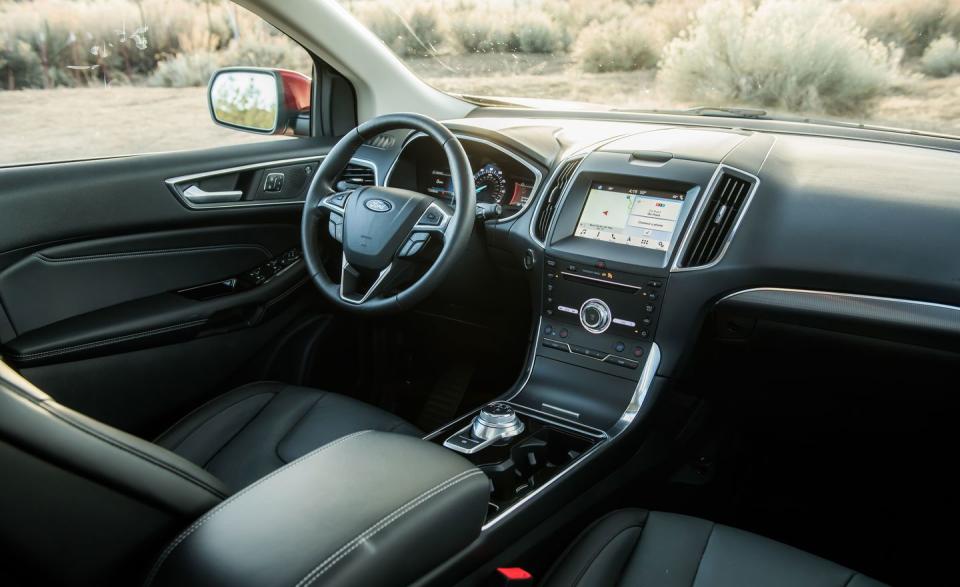
With 275 pound-feet of torque at 3000 rpm, the Edge offers ample oomph. But even its midpack zero-to-60-mph and quarter-mile times (6.8 and 15.3 seconds, respectively) overshoot its chassis. On the road, it is critically underdamped, resulting in hilarious, if terrifying, antics when pushed. Steady-state cornering is better. At 0.83 g, it produced the second-best lateral acceleration. Its road-crushing 4357 pounds, however, made it the heaviest vehicle here. Pair that weight with the weakest brakes in the test and it was the first to turn its pads to smoke. Ford's SUV was spookier in the mountains than even the soft-boiled Murano, which couldn't go quick enough to hurt itself.
But the Edge's defining traits, the ones that sequestered it to the back of the pack, were its tall, awkward proportions and high driving position. Every editor commented on its high hood, long dash, and bungled control placement. The bizarre relationship between the Edge's steering wheel, shifter, and pedals yields a driving position that seems to hark back to a time before man stood erect.
3rd Place:
Chevrolet Blazer
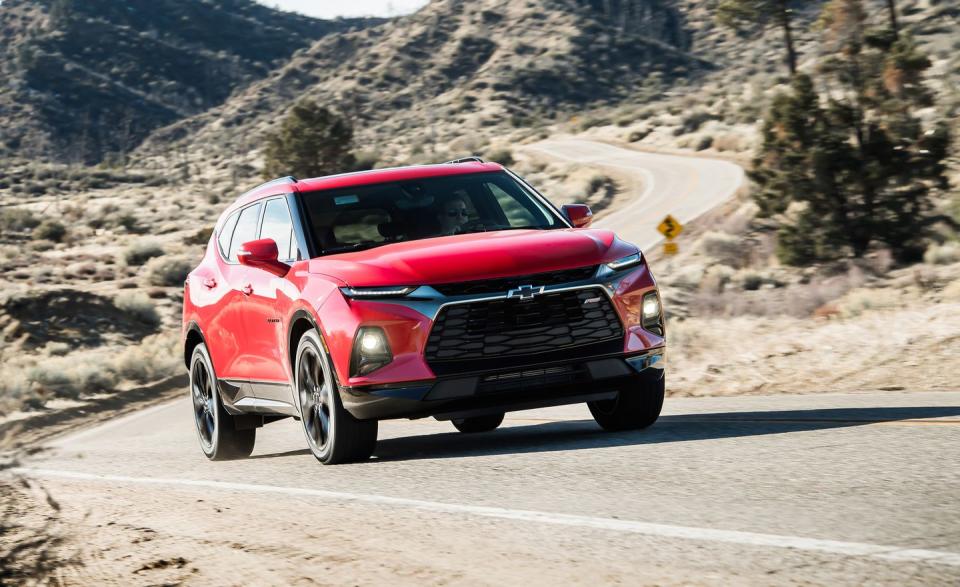
Highs: Rewarding control feel and response, quick.
Lows: Pricey, harshest ride, recalcitrant downshifts.
Verdict: An SUV for blazing down back roads and burning through your savings.
Here's the part of this comparison test where you call us hypocrites for not awarding the best-handling SUV the win like we have multiple times with Mazdas. You'd be right about the handling. The Blazer's 70-to-zero-mph braking, its slalom speed, and its lateral grip all top the board. More importantly, its precise steering and immediate brake-pedal response speak our language, and the Chevy has the best body control here. At speed, it comfortably corners as if it was tuned by engineers who care about chassis dynamics. In the mountains, it was our most rewarding driving partner and it dominated our chassis scores, even though its 21-inch wheels were the biggest in the group and contributed to the busiest ride. At 6.3 seconds, the Blazer was the second quickest to 60, and it hauled through the quarter-mile in the same position. But the sporting fantasy evaporates if you try to change gears manually. The Blazer's nine-speed downshifts lazily, and the shifter-mounted toggle isn't as intuitive or as easy to use as wheel-mounted paddles.
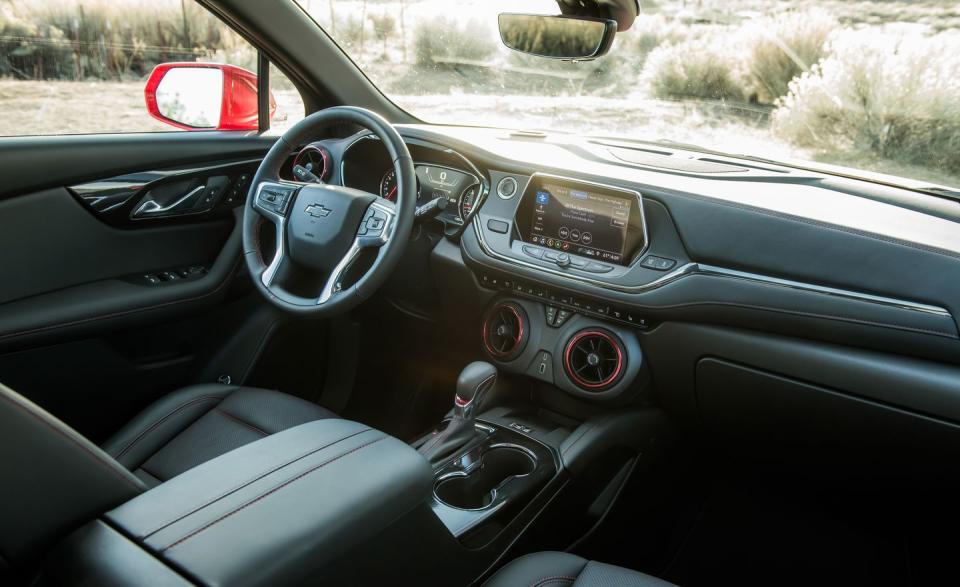
Inside, you'll find evidence of a genuine effort on GM's part. The instrument panel, gauges, and touchscreen are all thoroughly modern affairs. There's real styling here, much of it familiar. It shares the Camaro's vent-mounted temperature knobs, but the vents themselves blow on your knees. And the door panels are giant swaths of hard plastic, lacking the finish quality of most competitors, especially those finishing in front of it.
And here's the part of the test where we acknowledge that most SUV buyers care more about value, usability, and cost than they do about handling. The Blazer RS that Chevy sent us will set you back $2680 more than the next most expensive SUV here and almost $11,000 more than the Santa Fe, which is the cheapest. And it's not even the priciest version Chevy offers. We appreciate and respect that the GM team can create a capable-handling SUV, but it probably would have fared better here with a less costly, more pedestrian version. "Where's the value?" screamed the peanut gallery.
2nd Place:
Hyundai Santa Fe

Highs: Inexpensive, packaged like Costco, feature-laden.
Lows: Blasé control feel, merely adequate dynamics.
Verdict: Simple, usable, economical, effective. It's the practical family's choice.
The Santa Fe in this test did what Hyundais have been doing well for a decade now: It presented a solid case. It was just good enough on the road. After driving it harder than any owner ever will, we couldn't deny that it easily kept up. There was no flourish about it, no magic control feel, no trick differential helping it turn, and 'little power-the least in the group, a fact made evident by its 7.5-second zero-to-60 time, which ties for slowest with the Murano's. Nonetheless, we never waited for the Santa Fe.
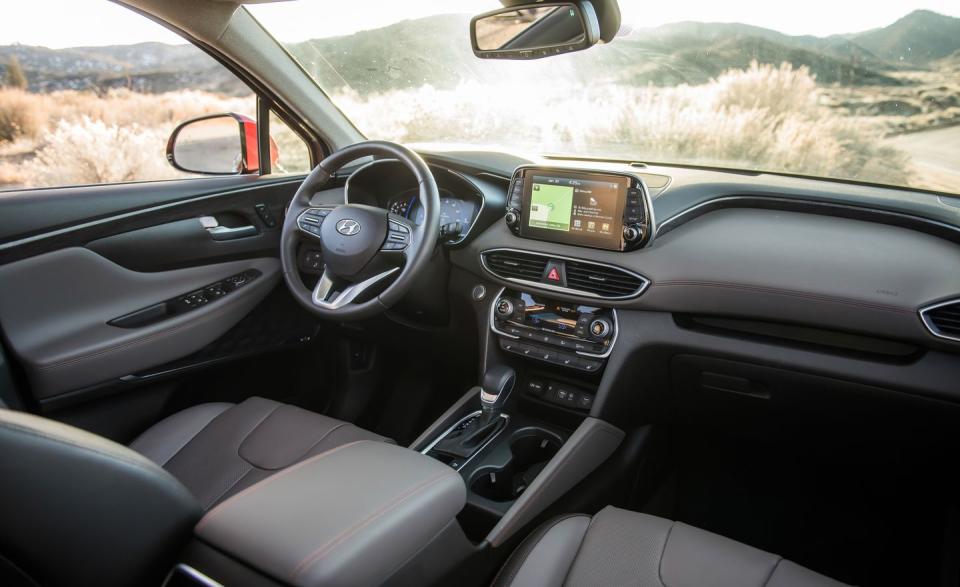
But despite its ho-hum attitude toward hard driving, it moves up the ranks thanks to an as-tested price that undercuts the second-cheapest contender by nearly $6000. (That vehicle also happened to win.) And it's not just the money. It's what the Santa Fe gives you for it. The Hyundai ruled our features and amenities scoring, packed with both useful tech-it's the only SUV here with a manually lockable center differential-and practical touches such as rear window shades.
Smart packaging helps the Santa Fe be both nimble enough to hang with the group and offer the passenger and cargo volume necessary to compete. It's the shortest, narrowest, and lightest vehicle here, yet it provides the most front passenger room. Secondary control layout is a win, with knobs for volume and tuning as well as two for climate control. Hyundai's touchscreen infotainment system is among the easiest to use in the industry. And the tasteful combination of complementary colors and attractive materials, including a unique denim-like headliner, captured our attention. The Hyundai finishes second because it's capable on the road, a practical family vehicle, and a meaningful value.
1st Place:
Honda Passport

Highs: Big on space, small from behind the wheel, quick, priced right.
Lows: Enough with the push-button shifter already, still needs more knobs.
Verdict: The best combination of utility and driving pleasure also comes with a reasonable price tag.
Put the pen down. We know the Passport's big brother, the Pilot, finished dead last in our 2017 three-row SUV comparison. But that was a different vehicle squaring off against a different set of competitors. What's more, downsizing gives Honda's Global Light Truck Platform better control of both its chassis and its powertrain. Despite riding 1.6 inches higher than its three-row brother, the Passport demonstrates competent body control. Our gripes about the nine-speed transmission's indecisiveness when automatically shifting have vanished, and the Passport's wheel-mounted paddles give drivers much-needed manual control.
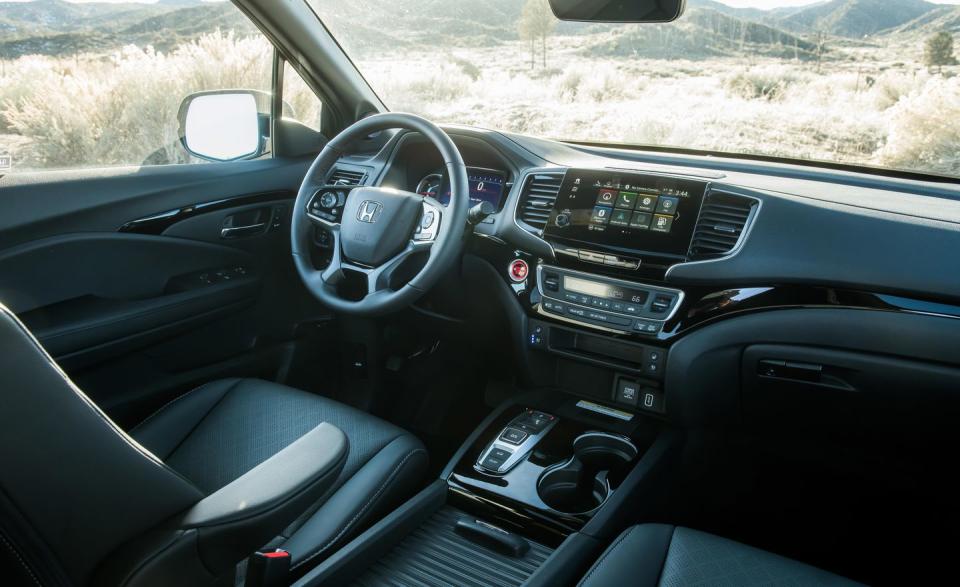
Snappy shifts and the V-6's 280 horsepower produced the best zero-to-60, quarter-mile, and 50-to-70 passing times in the group, even as the Passport earned the best observed fuel economy. And despite being the tallest competitor, the Honda still compelled us to drive it quickly, courtesy of its light, accurate steering and goes-where-it's-pointed response. Being the biggest inside didn't keep it from being light on its feet, though its stability control was rather intrusive during our handling tests.
With so much winning going on, it's hard to grumble, but we found a few misses. The push-button shifter annoyed us even after days behind the wheel, remaining the least intuitive and most time-consuming gearchange device in the test. Honda's infotainment interface-now with a volume knob!-is far from perfect: Just try tuning satellite radio stations quickly, we dare you. And there's no shortage of blatantly cheap plastic here, either.
But Honda squarely nails those details necessary to be a legit family-hauling utility wagon. The Passport is a picture of pragmatic service largely thanks to enormous interior space. Its pillars are thin and pushed far away, its greenhouse is massive, and it provides the most cargo volume here. Not only is the room ample, but Honda makes the best use of it by incorporating creative small-item storage throughout. If you're looking in the middle of crossover land for some real meat, the Passport has the most to offer.
From the April 2019 issue
('You Might Also Like',)

 Yahoo Finance
Yahoo Finance 